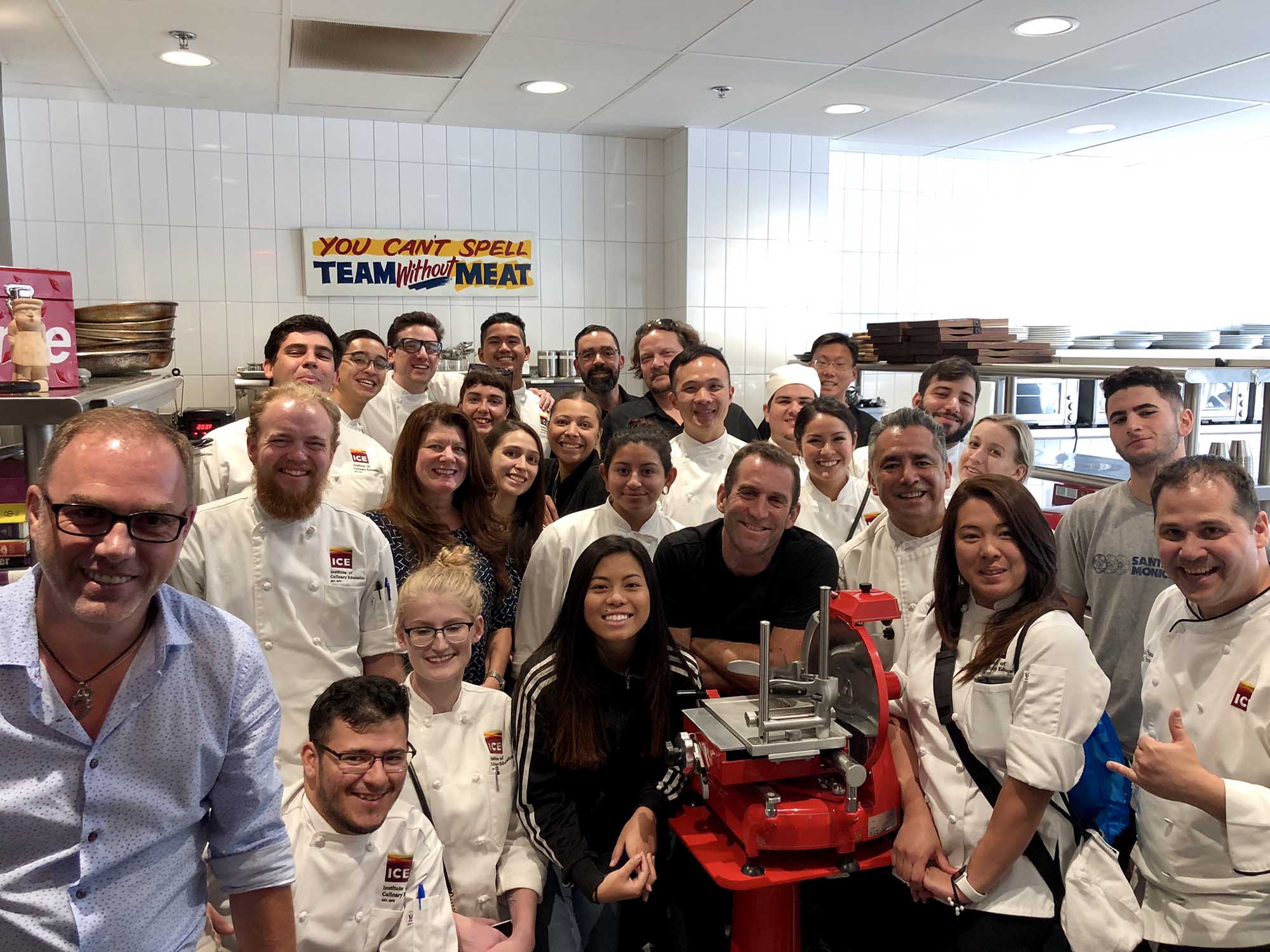Adam Perry Lang is one of America’s leading authorities on dry aging, but he’s certainly not one to brag. His reason for creating an “environmental chamber” — a subterranean dry-aging room beneath his eponymous eatery, APL Restaurant — goes to the heart of what he strives for as a chef: to care.
Last week, Chef Lang welcomed our Los Angeles students into his kitchen and dining room and guided a tour through his beloved underground dry-aging room, then shared his deep knowledge on the subject. Here are some of the many things we learned on the field trip.
While most steakhouse menus boast beef that has been dry aged for 28 days, APL’s menu is strikingly different with a section labeled: 100+ Day Dry Aged Beef. No, it’s not a gimmick to wow diners. As Lang explains, despite industry standards, there are many variables for how long you can and should age a steak.
”Ever see a fish after you catch it?” he asks. “It goes into rigor mortis; it gets stiff. It’s a natural reaction to the life cycle process; it's seized by over-stimulated hormones and adrenaline runs through it and causes the nerves to react. Then it takes a certain period of time for it to relax. In the case of beef, for maximum tenderness, the industry determined it’s 28 days, anything past that is for flavor. I disagree. It is this variable that depends on the conditions — what you have around it, what you want to get and who your audience is.

“There’s no absolute. I’ve dry aged past 365 days, a full year,” he says. “But the meat itself has to exhibit certain characteristics for me to take that meat on that journey.” The most important factor he uses to determine how long to age a piece of meat is the marbling, or visible distribution of fat.
Chef Lang seeks what he describes as intense and almost web-like marbling for his extended dry-aging process. “Anytime you subject something with water in it with age and a certain environment, that water’s going to get pulled out,” he explains. “Muscle has more water than fat. If I have a higher degree of fat inside the meat itself, I’m going to have less product loss and more flavor.”
He treats leaner meats differently, still factoring in the environment, humidity and airflow. “Slower allows a more gradual progression of flavor,” says Chef Lang. “For something leaner, I wouldn’t go much past 28 to 48 days.”
He prefers, however, to focus on that heavily marbled, prized piece of beef. “I want knock-your-socks-off kind of flavor instead of creating something that’s just tender and good,” says Chef Lang, whose 100-day version is akin to cutting into foie gras as a result of his approach: high humidity, aggressive air flow and a lower temperature chamber between 33°F and 38°F.
While other steakhouses keep details under lock and key, Lang is happy to share his knowledge and help guide fellow chefs. When working on his first steakhouse in New York, he had to do his own legwork when those who had come before him weren’t as forthcoming with information. Lang resourcefully tracked down the refrigerator repairman from the world-famous Peter Luger Steakhouse in Brooklyn and spoke to old-timers who dry-aged beef in the Bronx. This path led him to not only build four environmental chambers in New York, London, Las Vegas and Los Angeles; it ultimately resulted in his passion for forging steak knives.
Becoming a foremost expert on dry aging wasn’t Lang’s intention. Like many mid-career chefs, he wanted to finally have a place he could call his own — the cuisine would be barbecue and the technique: live-fire cooking. After 12 years in fine-dining restaurants, from Le Cirque in New York to Guy Savoy in Paris, Lang wanted to shift focus to food that evoked emotional attachment.
Without enough cash in the bank, he approached investors who would finance him if he developed their steakhouse, which happened to be housed in a Manhattan strip club. Lang believed that if he worked on their steakhouse, these investors would make all of his barbecue dreams come true. He opened Daisy May's BBQ in New York City in 2003, which had a successful run through 2017.
“Dry aging was a byproduct of me following my passion,” explains Lang. “As I got deeper into dry aging, my hair started to stand up on end and I started to figure out my journey.”

Now he’s paved the way for other chefs to understand dry aging better and to create their own dry-aging facilities. To culinary students and culinary management students who hope to open a steakhouse and perhaps go down this same road, Lang has advice.
- The most important of the three factors in dry aging is air velocity: “If meat becomes too wet, it creates a condition that makes it available to other types of mold and flavors. We don’t want that. We want to dry it out and encourage the right kind of mold. Drying out the meat will concentrate the flavor.”
- The dry-aging process is reliant upon the product. That doesn’t start with the animal, but with the people. Lang attends bull auctions and observes how sellers handle their animals, where their seed stock is from, the farmers’ plights, the conditions of the slaughterhouse, etc. “I start the process really early on,” says Lang, who sources the majority of the beef for APL from Nebraska. “It really depends on where the best cattle are coming from.”
“Every chef is different,” he tells students. “That’s the best advice I can give you. Trends come and go; it doesn’t matter what you make; if you can, do it good and care about it. And be yourself. If you have the passion and drive and find your calling in this whole thing, you will have something really rewarding.”
Learn from Los Angeles chefs in ICE's Culinary Arts program in Pasadena, California.




